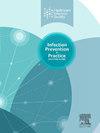Status of infection prevention and control in Cameroon healthcare facilities: lessons learned from the WHO COVID-19 scorecard tool under the hierarchy of control model
IF 1.9
Q3 INFECTIOUS DISEASES
引用次数: 0
Abstract
Background
Infection prevention and control (IPC) helps prevent disease transmission in healthcare facilities. There is a dearth of information on the implementation of IPC during the COVID-19 outbreak in Cameroon using the recommended WHO COVID-19 IPC scorecard tool. The present study assessed healthcare facilities' compliance to IPC by continuous assessments, with an evaluation of the tool using the hierarchy of control theory.
Methods
This cross-sectional study was conducted in the 10 administrative regions of Cameroon by evaluating healthcare facilities prioritized by the Ministry of Public Health as high-risk facilities between March 2020 and November 2023. Comparisons were made regarding the facilities' ownership, level and status.
Results
2,188 assessments from 1,358 healthcare facilities were collected. The median IPC scores at each evaluation were between the intermediate and advanced level, with a bias linked with decreasing selection of facilities. However, only 172 (13%) healthcare facilities achieved advanced IPC score (≥75%). Higher IPC scores were found in hospitals (p<0.001) and in private facilities (p=0.02). Predictors of good IPC compliance were hospital (OR=3.7, CI: 1.4–9.8) and private facility (OR=2.3, CI: 1.6–3.3). The tool met the five domains of the hierarchy of control model.
Conclusion
Repeated IPC assessments using recommended tools contribute to a better compliance of IPC by healthcare facilities in resources constrained settings.
喀麦隆医疗机构的感染预防和控制现状:从世卫组织 COVID-19 计分卡工具中汲取的分级控制模式的经验教训
背景感染预防与控制(IPC)有助于防止疾病在医疗机构中传播。关于喀麦隆在 COVID-19 爆发期间使用世界卫生组织推荐的 COVID-19 IPC 计分卡工具实施 IPC 的情况,目前还缺乏相关信息。这项横断面研究在喀麦隆的 10 个行政区进行,对公共卫生部在 2020 年 3 月至 2023 年 11 月期间优先考虑的高风险医疗机构进行了评估。结果 收集了来自 1,358 家医疗机构的 2,188 份评估报告。每次评估的 IPC 得分中位数介于中级和高级之间,其中的偏差与设施选择的减少有关。然而,只有 172 家(13%)医疗机构达到了 IPC 高级水平(≥75%)。医院(p<0.001)和私营机构(p=0.02)的 IPC 得分更高。医院(OR=3.7,CI:1.4-9.8)和私营机构(OR=2.3,CI:1.6-3.3)是IPC符合性良好的预测因素。结论在资源有限的环境中,使用推荐工具重复进行 IPC 评估有助于医疗机构更好地遵守 IPC。
本文章由计算机程序翻译,如有差异,请以英文原文为准。
求助全文
约1分钟内获得全文
求助全文
来源期刊

Infection Prevention in Practice
Medicine-Public Health, Environmental and Occupational Health
CiteScore
4.80
自引率
0.00%
发文量
58
审稿时长
61 days
 求助内容:
求助内容: 应助结果提醒方式:
应助结果提醒方式:


